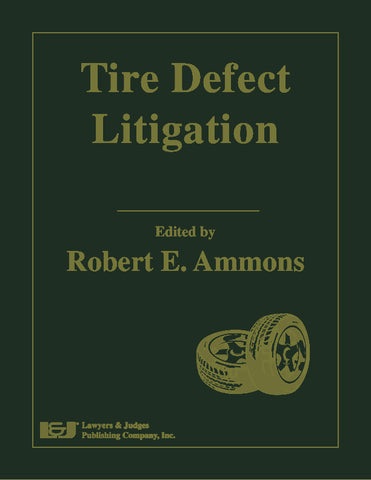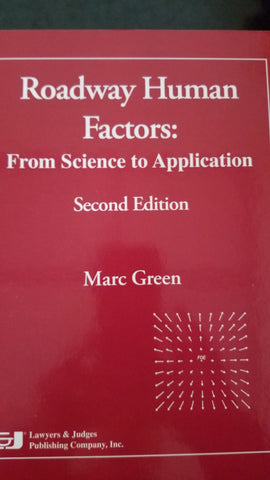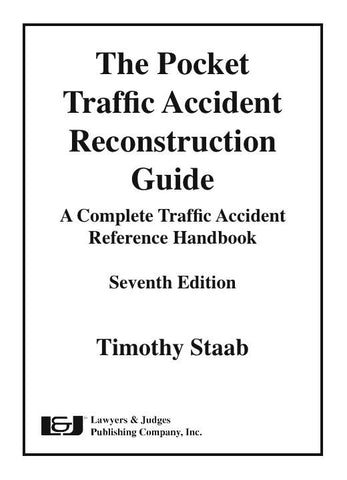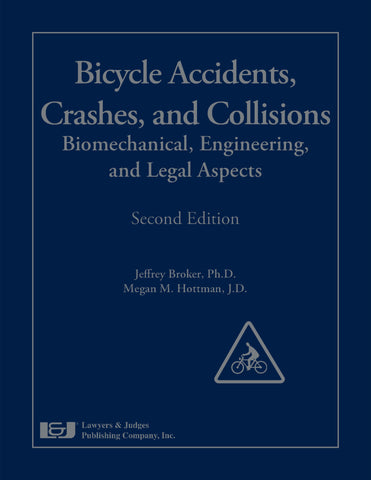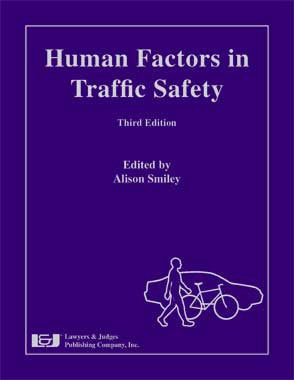
Human Factors in Traffic Safety, Third Edition
- Editor: Alison Smiley. Contributors: Gerson Alexander, Cher Carney, Robert Dewar, Bonnie M. Dobbs, Paul Green, Fred Hanscom, Sarah Keller, Jeff Linkenbach, Michele Lustman, Daniel V. McGehee, Herbert Moskowitz, Paul Olson, Jay Otto, Michelle L. Reyes, James E. W. Roseborough, Alison Smiley, Thomas Smahel, Steve Swinford, Louis Tijerina, Nicholas Ward, David L. Wiesenthal.
- ISBN 10: 1-933264-88-8
- ISBN 13: 978-1-933264-88-2
- Copyright Date Ed: October 10, 2015
- Pages: 550 pages
- Binding Information: Hardcover
- Size: 8.5 ✕ 11 Inches (US)
There are more than 175 million licensed drivers in the United States. Combined with the many pedestrians, bicyclists, motorcyclists, and other road users, this creates an interesting mix of elements with very different characteristics. Moving these elements efficiently and safely to their destinations presents a major challenge, particularly in densely populated areas. Human Factors in Traffic Safety, Third Edition will provide guidance in how to identify these elements in your collision investigations. The authors introduce you to the ways in which designers of vehicles and roadways historically often did not take into account the full range of road user characteristics. The book discusses the substantial improvements in design principles and standards achieved over the years due to the concerted effort by concerned individuals interested in roadway and vehicle design and its impact on traffic safety.
Most importantly, this book introduces you to the behavior of the road user. Driver limitations and driver or pedestrian error are the major factors in traffic accidents, contributing to about 90% of roadway crashes. Driver behavior, however, is often the most complex and yet least understood element in the roadway system. A wide variety of perspectives on human factors and driver behavior are covered ranging from the design of roads, vehicles and traffic control devices to emotional and motivational determinants of driver behavior. Many traffic safety experts have contributed to this book in order to give you a comprehensive introduction to human factors as it pertains to driver and pedestrian behavior and traffic safety.
This new edition has been extensively revised. All chapters have been edited and updated, along with new chapters on aggressive driving, intersection and roundabout crashes, positive guidance, and the traffic safety culture paradigm. If you are involved with accident investigation or the promotion of traffic safety in any capacity, this book is an essential part of your library.
Topics Include
- Understanding Road Users
- Perception
- Information Processing, Attention, and Driver Workload
- Where Drivers Look while Driving (and for How Long)
- Driver Perception-Response Time
- Young Drivers
- Older Drivers
- Aggressive Driving
- Alcohol and Drugs
- Driver Distraction and Road Safety
- Fatigue and Driving
- Medical Conditions and Driving
- The Visibility Provided by Vehicle Lighting Systems
- Positive Guidance
- Intersection and Roundabout Crashes
- Lane Departure Crashes
- Traffic Control Devices
- Highway Work Zones
- Pedestrians and Bicyclists
- The Traffic Safety Culture Paradigm
Table of Contents
Preface
Chapter 1: Understanding Road Users
Alison Smiley
1.1 Introduction to Human Factors in Traffic Safety
1.2 Definition of Human Factors
1.3 Beginnings of Human Factors
1.4 Human Factors in Road Transportation
1.5 Human Factors and Crash Causation
1.6 Preventing Crashes
A. Education and Regulation
B. Enforcement
C. Engineering
1.7 Summary
References
Chapter 2: Perception
Robert Dewar and Paul Olson
2.1 Introduction
2.2 Perception and Collisions
A. Look-but-Fail-to-See Collisions
2.3 Visual Perception
A. Background
B. The Eye
C. Photometric Terms
D. Contrast
E. Drivers’ Field of View
F. Useful Field of View
G. Visual Search and Attention
2.4 Auditory Information
A. Identifying Hazards by Sound
2.5 Other Senses
2.6 Perception of the Road
A. Drivers’ Awareness and Understanding of the Roadway Environment
2.7 Hazard Detection and Recognition
2.8 Reduced Visibility Conditions
A. Darkness
B. Fog
C. Rain
D. Snow
2.9 Perception of Speed
A. The Role of Speed in Driving
B. Speed Perception and Road Environment Characteristics
C. Speed Perception and Vehicle Size
D. Speed Adaptation
E. Car Following and Rear-End Collisions
2.10 Summary
References
Chapter 3: Information Processing, Attention, and Driver Workload
Louis Tijerina
3.1 Introduction
3.2 Two Ways of Seeing
A. Vision-for-Action in Driving
B. Vision-for-Identification in Driving
3.3 Expectancies and Top-Down vs. Bottom-Up Processing
3.4 Driver Attention and Vigilance
A. Selective Attention
B. Vigilance
C. Mind Wandering Lapses in Sustained Attention
D. Divided Attention and Automaticity
E. Timesharing and Driver Eye Glance Behavior
3.5 Models of Attention
3.6 Memory, Attention, and Driving
3.7 Driver Decision Making About What to Do Next
3.8 Spare Capacity
3.9 Driver Workload
A. Measures of Driver Workload
B. Factors that Increase Driver Workload
3.10 Driver Underload and Fatigue
3.11 Conclusion
References
Chapter 4: Where Drivers Look while Driving (and for How Long)
>Paul Green
4.1 How Glance Behavior Is Described
A. Terms Used to Describe Glance Behavior
B. Some General Characteristics of Driver Glance Behavior
C. How Glance Behavior is Measured
4.2 Eye Related Measures That Are Most Indicative of Crash Risk
4.3 Looking at an Object Does Not Guarantee the Object is Noticed
4.4 Typical Looking Behavior
4.5 How the Road Environment Affects Glance Behavior
A. Where Drivers Look When Driving Curves
B. How Traffic and Other External Demands Affect Where Drivers Look
C. How Eye Fixation Data Benn Used to Evaluate Road and Vehicle Markings, and Signs
D. How Scene Illumination Affects Glance Characteristics
4.6 How Driver Characteristics Affect Glance Behavior
A. How Driving Experience Affects Glance Behavior
B. How Fatigue Affects Glance Behavior
C. How Alcohol and Other Drugs Affect Glance Behavior
4.7 How the Vehicle Type Affects Glance Behavior
4.8 How In-vehicle Task and Driver Interface Affects Glance Behavior
A. Typical Looking Behavior for In-Vehicle Devices
B. How Long Drivers Believe They Can Look at the Vehicle Interior
4.9 Conclusions
4.10 A Final Thought
Additional Reading
References
Chapter 5: Driver Perception-Response Time
Paul Olson
5.1 Introduction
5.2 Background
A. Definition
B. Stages Of Perception-response Time
5.3 Driver Perception-Response Time
5.4 Decision Sight Distance
5.5 Overview of Research
5.6 Factors Affecting Perception-Response Time
A. Detection
B. Identification
C. Decision
D. Response
E. Night vs. Day
F. Drugs, Alcohol, Driver Fatigue
G. Age and Gender
H. Cognitive Load
I. Angular Position of the Target
5.7 Situations that Do Not Fit the Perception-Response Model
A. No Clearly Defined Entry
B. Erroneous Assumption or Identification
5.8 Summary and Conclusions
References
Chapter 6: Young Drivers
Michelle L. Reyes, Cher Carney, and Daniel V. McGehee
6.1 Introduction
6.2 Characteristics of Motor Vehicle Crashes Involving Young Drivers
A. Time of Day
B. Day of Week
C. Crash Type
D. Rural vs. Urban Locales
E. Vehicle Type
F. Seat Belt Use
6.3 Young Driver Characteristics
A. Gender
B. Vehicle Ownership and Access
C. Developmental Factors
D. Attentional Factors
6.4 Improving Young Driver Safety
A. The Role of Parents
B. Driver Education
C. Graduated Driver Licensing
D. Specialized Novice Driver Training
E. Technology-Based Interventions
6.5 Conclusions
References
Chapter 7: Older Drivers
Robert Dewar
7.1 Introduction
7.2 Demographics of Older Drivers
7.3 Older Driver Crashes
7.4 Increased Vulnerability of the Elderly
7.5 Difficulties Experienced by Older Drivers
7.6 Sensory and Perceptual Changes
A. Ocular Changes
B. Accommodation
C. Visual Fields
D. Eye Movements and Visual Search
E. Contrast Sensitivity
F. Sensitivity to Light
G. Dark Adaptation
H. Glare and Glare Recovery
I. Visual Acuity
J. Dynamic Visual Acuity
K. Visual Diseases
7.7 Attention and Cognition
7.8 Driver Distraction
7.9 Hazard Perception
7.10 Memory
7.11 Psychomotor performance
7.12 Stress
7.13 Older Drivers and Traffic Control Devices
7.14 Vehicle Design
7.15 Road Design
7.16 Self-regulation and Driving Cessation
7.17 Conclusions
References
Chapter 8: Aggressive Driving
David L. Wiesenthal, Michele Lustman, and James Roseborough
8.1 Introduction
8.2 Definitions and Portrayals of Aggressive Driving
A. The Public’s Perception of Aggressive Driving
B. Aggressive Driving and the Media
C. Entertainment Media Portrayals of Aggressive Driving
D. Defining Driver Aggression
8.3 Variables Related to Aggressive Driving
A. Gender Differences in Risky Driving
B. Anonymity and Aggressive Behaviour
C. Vengeance and Aggressive Behaviour
8.4 Personality and Individual Differences
A. Trait Aggression
B. Trait Verbal and Physical Aggression
C. Trait Anger
D. Five-Factor Personality Model
E. Impulsivity
F. Sensation-Seeking
G. Narcissism
H. Type-A Personality
I. Macho-Personality
8.5 Summary: Personality Variables and Individual Differences
8.6 Theoretical Perspectives on Aggressive Driving
8.7 Alternative Explanations for Greater Risk-Taking in Young Males
8.8 Aggressive Driving Countermeasures
A. Technological Approaches
B. Incentive Based Strategies
C. Psychotherapeutic Approaches
D. Vehicle Design Changes to Reduce Aggressive Driving
E. Legislation and Policing
F. Aggressive Driver Imaging
G. Media Campaigns Against Aggressive Driving
H. Promotion of Mass Transportation
8.9 Summary: Aggressive Driving Countermeasures
Acknowledgements
References
Chapter 9: Alcohol and Drugs
Herbert Moskowitz
9.1 Introduction
9.2 Alcohol Use While Driving
9.3 Alcohol and Crashes
9.4 Single Vehicle Collisions
9.5 Measures of Intoxication
9.6 Driving Abilities Impaired by Alcohol
9.7 Rate of Alcohol Consumption
9.8 Alcohol and Fatigue
9.9 Alcohol and Aggression
9.10 Alcohol and Degree of Injury
9.11 Drug Effects
Endnotes
References
Chapter 10: Driver Distraction and Road Safety
Louis Tijerina
10.1 General Introduction
10.2 Driver Distraction: Definitions and Types
A. Defining Driver Distraction
B. Types of Driver Distraction
C. Section Summary
10.3 Driver Distraction Reported in U.S. Traffic Crash Databases
A. Crashes
B. Injuries
C. Fatalities
D. Section Summary
10.4 Epidemiological Studies of Driver Distraction and Road Safety
A. Section Summary
10.5 Naturalistic Driving Research
A. The Naturalistic Driving Paradigm
B. Naturalistic Driving Crash and Near-Crash Results
C. New Findings on the Importance of the Last Glance Away
D. Criticisms of Naturalistic Driving Research
E. Section Summary
10.6 Distraction Sources in Driving
A. Non-Technology Distraction Sources in the Vehicle
B. Distractions Associated with In-vehicle Integrated Systems
C. High-Technology In-Vehicle Distractions and Carried-In Devices
D. Listening to Music
E. Distractions Outside of the Vehicle
F. Distraction as Inattention from Within the Driver
G. Section Summary
10.7 Cell Phones, Hands-Free Systems and Road Safety
A. Cell Phone-Related Crashes
B. Cell Phone Distraction-Related Fatalities
C. Naturalistic Driving Results for Cell Phone-Related Distractions
D. Effects of Hand-held Cell Phone and Texting Bans on Crashes
E. Research into Hands-free Systems, Texting, and Cognitive Distraction
F. Section Summary
10.8 The Cognitive Aspects of Driver Distraction
A. Top-Down vs. Bottom-Up Processing
B. Controlled Processing vs. Automaticity
C. Motivations and Driver Decision-making
D. Expectancies and Deciding what to Attend to Next
E. Novice/Teen Drivers and Expectancy
F. Spare Capacity and Driver Distraction
G. Section Summary
10.9 Discussion
A. Experimental vs. Naturalistic Driving Research Results
B. Improvements in Naturalistic Driving Research
C. Emerging Research on Driver Self-Regulation and Adaptations for Secondary Tasks
References
Chapter 11: Fatigue and Driving
Alison Smiley
11.1 Introduction
A. Definitions of Fatigue
B. Measurement of Fatigue
C. The Extent of the Fatigue Problem
D. Fatigue and Crashes
11.2 Causes of Fatigue
A. Long Hours
B. Time of Day
C. Inadequate Sleep
11.3 Countermeasures to Fatigue
A. Rest Breaks
B. Food and Caffeine
C. Games and Music
D. Naps
E. Education
F. Intelligent Transport Systems (ITS) Countermeasures
G. Rumble Strips
11.4 Summary
11.5 Additional Reading
References
Chapter 12: Medical Conditions and Driving
Bonnie M. Dobbs
12.1 Introduction
12.2 An Overview of Functional Abilities Needed for Driving
12.3 Impact of Medical Conditions on Functional Abilities
12.4 Identifying and Assessing the Medically At-Risk/Impaired Driver
A. Guidelines
B. Screening tools
C. Assessments
12.5 Medical Conditions with Episodic Outcomes
A. Epilepsy
B. Diabetes
12.6 Medical Conditions with Persistent Outcomes
A. Cerebrovascular
B. Cardiovascular
C. Neurological
12.7 Medications
12.8 Supporting the Medically Impaired Driver
A. Restricted Licensing
B. Driving Cessation
12.9 Conclusions and Future Directions
References
Chapter 13: The Visibility Provided by Vehicle Lighting Systems
Paul Olson
13.1 Introduction
13.2 The Importance of Target Contrast
A. Definition
B. Calculating Contrast
13.3 The Reflectivity of Objects in the Real World
13.4 Driver Vision at Night
A. Vehicle Lighting Systems
B. The Visibility Provided by Automotive Headlamps
13.5 Twilight Visibility
13.6 Nighttime Driving Speeds
13.7 When Drivers “Overdrive” Their Headlamps
13.8 Chapter Summary
References
Chapter 14: Positive Guidance
Gerson Alexander
14.1 A Brief History
14.2 The Basic Concept
14.3 Task Complexity
14.4 Principles of Information Placement
14.5 Expectancy
14.6 Summary
References
Chapter 15: Intersection and Roundabout Crashes
Alison Smiley
15.1 Introduction
A. Intersections
B. Roundabouts
15.2 Detecting the Intersection or Roundabout
A. Human Factors Aspects of Detection
B. Countermeasures: Detection
15.3 Identification Of Right-of-way
A. Human Factors Aspects of Identification
B. Countermeasures: Identification of Right-of-Way
15.4 Visual Search
A. Human Factors Aspects of Visual Search
B. Countermeasures: Visual Search
15.5 Gap Judgment
A. Human Factors Aspects of Gap Judgment
B. Countermeasures: Gap Judgment
15.6 Decision-Making in the Dilemma Zone
A. Human Factors Aspects of Decision Making
B. Countermeasures: Dilemma Zone
15.7 Negotiating the Intersection/Roundabout
A. Human Factors Aspects of Negotiating
B. Countermeasures: Intersection/Roundabout Negotiation
15.8 Older and Younger Drivers at Intersections
A. Age-Related Crash Risks At Intersections
B. Age-Related Behavioral Differences
C. Countermeasures for Older and Younger Drivers
15.9 Advanced Driver Assistance Systems
15.10 Summary
15.11 Further Reading
15.12 Acknowledgements
References
Chapter 16: Lane Departure Crashes
Alison Smiley
16.1 Introduction
16.2 Case Studies of Lane Departure Crashes
A. Run-off-Road Crashes
B. Head-on Crashes
16.3 Human Factors In Lane Departure Crashes
A. Driver Behavior in Curves
B. Loss of Directional Control
C. Inattention
D. Driver Impairment
16.4 Countermeasures and their Effectiveness
A. Reducing Speed in Curves
B. Improving Directional Control
C. Alerting Inattentive and Impaired Drivers
16.5 Summary
References
Chapter 17: Traffic Control Devices
Alison Smiley and Thomas Smahel
17.1 Introduction
17.2 Overview of Driver Needs and TCDs
A. Visual Search and Traffic Signs
B. Information Processing
C. Summary of Driver Limitations
17.3 Conspicuity
A. Conspicuity and Visual Clutter
B. Conspicuity, Size, and Placement
C. Conspicuity and Retroreflectivity
17.4 Legibility
A. Driver Characteristics and Legibility
B. Letter Characteristics and Legibility
C. Sign Characteristics and Legibility
D. Environmental Characteristics and Legibility
17.5 Visibility of Delineation
A. Preview Distance
B. Contrast and Retroreflectivity
C. Glare
D. PRPMs
E. Driver Characteristics
17.6 Comprehension
A. Comprehension of Common Traffic Symbols and Words
B. Acceptable Level of Sign Comprehension
C. Comprehension of Traffic Signals
17.7 Information Load
A. Message Length and Reading Time: Static Signs
B. Message Length and Reading Time: VMS
C. Phasing and Flashing of Messages
D. Sign Layout
17.8 Sign Placement
17.9 Driver Response
A. Speed Limit Signs
B. Speed Advisory Signs
C. Activated Speed Signs
D. Animal Crossing Warning
E. Lane Markings, PRPMs and PMDs
F. Chevron Signs
G. Pavement Arrow Markings
H. Transverse Lane Markings
I. Rumble Strips
17.10 Summary
References
Chapter 18: Highway Work Zones
Fred Hanscom and Robert Dewar
18.1 Human Factors and Work Zones
18.2 Collisions in Work Zones
A. Problems With Collision Data
B. The Collision Picture
18.3 Drivers in Work Zones
A. Driver Information Needs in Work Zones
B. Speed Selection and Control
C. Nighttime Conditions
D. Driver Behavior and Opinions
E. Older Drivers
18.4 Pedestrians and Cyclists in Work Zones
A. Background
B. Pedestrian, Cyclist, and Worker Accident Problem
C. The Pedestrian in a Work Zone Environment
D. The Cyclist in a Work Zone Environment
E. Conspicuous Work Zone Attire
F. Traffic Control Treatments
G. Pedestrian Safety Treatments
18.5 Large Vehicles in Work Zones
18.6 Work Zone Roadway Geometrics
18.7 Traffic Control Devices
A. Static Signs
B. Augmented Static Sign Arrays
C. Pavement Markings
D. Channelizing Devices
E. Changeable Message Signs
F. Other Devices
18.8 ITS Applications in Work Zones
A. National ITS Architecture
B. Case Studies and Evaluations of ITS Work Zone Applications
C. Summary of ITS Work Zone Applications
18.9 Human-Factors Based Collision Countermeasures
18.10 Conclusions
References
Chapter 19: Pedestrians and Bicyclists
Robert Dewar
19.1 Introduction
19.2 The Pedestrian’s Task
19.3 Pedestrian Safety
19.4 Pedestrian and Driver Behavior
19.5 Walking speed
19.6 Distracted Pedestrians
19.7 Alcohol Use
19.8 Visually Impaired Pedestrians
19.9 Physically Handicapped Pedestrians
19.10 Handicapped Pedestrian Safety Countermeasures
19.11 Older Pedestrians
19.12 Child Pedestrians
19.13 Nighttime Conditions
19.14 Winter Conditions
19.15 Roadway Design
A. Introduction
B. One-Way Streets
C. Highways
D. Intersections
E. Roundabouts
F. Road Diets
G. Road Safety Audits
19.16 Road Design Countermeasures
19.17 Pedestrians in Work Zones
19.18 Traffic Control Devices For Pedestrians
19.19 Intelligent Transportation Systems
19.20 Bicycle Safety
19.21 Cyclists’ Behavior
19.22 Cyclists’ Perception of Risk
19.23 Alcohol Use
19.24 Older Cyclists
19.25 Younger Cyclists
19.26 Road Design and Cyclist Safety
19.27 Night Conditions and Cyclist Safety
19.28 Traffic Control Devices for cyclists
19.29 Other Non-Motorized Transportation Modes
A. In-line skates
B. Skateboards
C. Heelys
D. Scooters
19.30 Conclusions
References
Chapter 20: The Traffic Safety Culture Paradigm
Nicholas Ward, Jay Otto, Steve Swinford, Sarah Keller, and Jeff Linkenbach
20.1 Introduction
20.2 Concepts
20.3 Theories
A. Social Ecology Theory
B. Self-Categorization Theory
C. Value – Belief – Norm Theory
D. Theory of Planned Behavior
E. The Prototype Willingness Model
20.4 Strategies
A. Values
B. Beliefs
C. Frames
D. Attitudes
E. Images
F. Norms
G. Perceived Control
20.5 Demonstration
A. Development Process
B. Application and Evaluation Example
20.6 Conclusion
References
About the Contributors
Index

